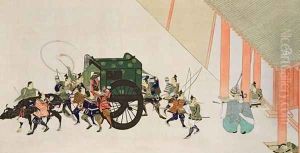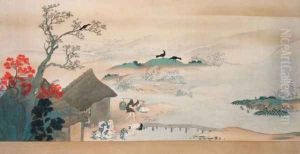Gukei, Sumiyoshi Hirozumi Paintings
Sumiyoshi Hirozumi, also known as Gukei, was a Japanese painter born in 1631 in Kyoto. He was a member of the Sumiyoshi family of painters, who were known for their contributions to the Rinpa school of painting, one of the major historical schools of Japanese painting that emerged in the early Edo period. The Rinpa school is characterized by its bold compositions, use of bright colors, and highly decorative designs, often emphasizing motifs from nature and classical literature.
Gukei was the grandson of Sumiyoshi Jokei, who was a court painter and also a member of the Sumiyoshi lineage. Under the guidance of his family, Gukei learned the craft of painting and was deeply influenced by the aesthetic principles of the Rinpa tradition. He was particularly known for his depictions of classical Japanese themes, such as scenes from The Tale of Genji and other Heian period literature, as well as landscapes and bird-and-flower paintings.
During his lifetime, Gukei worked to maintain the stylistic qualities of the Rinpa school while also integrating his own personal style. He became known for his delicate and refined brushwork, and his ability to capture the essence of his subjects with minimal yet expressive strokes. Gukei's works often reflected the elegant and aristocratic tastes of the Kyoto nobility, who were among his patrons.
Gukei’s contributions to the Rinpa school helped to define its stylistic development well into the 18th century. After his death in 1705, the Sumiyoshi family continued to be influential in the world of Japanese painting, with later generations adapting and evolving the Rinpa aesthetic to suit the tastes and sensibilities of their own times. Gukei's legacy is that of a pivotal figure in the perpetuation and refinement of the Rinpa tradition, bridging the early foundations laid by the school's founders with the continued innovation of subsequent artists.

